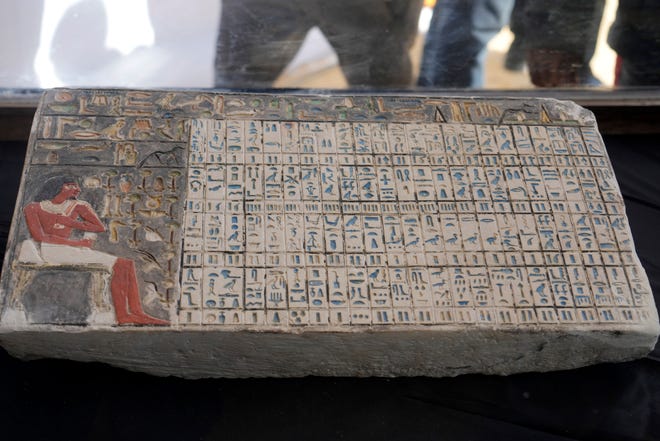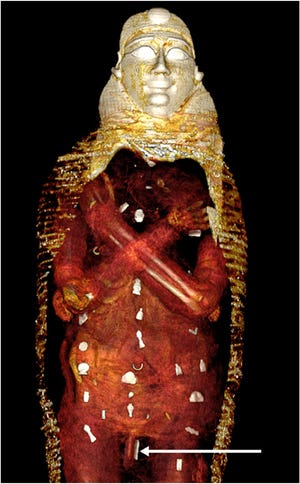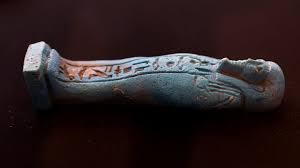Egyptian archaeologists and researchers have unveiled a treasure trove of artifacts recently, including what may be the oldest and most intact mummy ever found.
A team of Egyptologists on Thursday announced the discovery of several ancient tombs at a Pharaonic necropolis just outside of the capital of Cairo. Among the findings: a mummy belonging to a man called Heka-shepes sealed in a large rectangular limestone sarcophagus about 4,300 years ago, Zahi Hawass, director of the excavation, said in a post on Instagram.
The mummy, “found inside covered with gold leaf … may be the oldest and most complete mummy found in Egypt to date,” he said.
The find, dating from about 2500 B.C. to 2100 B.C., in the fifth and sixth dynasties of the Old Kingdom, is part of a yearlong excavation near the Saqqara pyramids.
The new discoveries were found beneath an ancient stone enclosure known as Gisr el-Mudir. ‘‘I put my head inside to see what was inside the sarcophagus: A beautiful mummy of a man completely covered in layers of gold,’’ Hawass told The Associated Press.

Also uncovered: a tomb belonged to a priest from the fifth dynasty known as Khnumdjedef, while the other tomb belonged to a palace official named Meri, who held the title of “the keeper of the secrets,” the team said.
Other major findings from the excavation include statues, amulets, and a well-preserved sarcophagus.
Ancient Egyptian family plot found
Archaeologists also disclosed several recent discoveries about 400 miles to the south – including a family burial plot dating back about 4,000 years.
The uncovering of the burial site, found at the Dra Abu el-Naga necropolis (or cemetery) on the west bank of the Nile in the city of Luxor, is the first found from the ancient Egyptian Thirteenth Dynasty, which dates back beyond 1780 B.C., according to Mostafa Waziry, an Egyptologist and the secretary-general of the supreme council of antiquities at the Egyptian Ministry of Tourism and Antiquities.
“The discovery is the first of its kind,” Waziry said in a posting on Instagram.
Discoveries at the site included a pink granite sarcophagus weighing about 11 tons, inscribed with the name of a minister named Ankho, who lived during the reign of King Sobekhotep II during the 13th Dynasty, Fathy Yaseen, director general of antiquities of Upper Egypt, told CBS News about the site.
“We have discovered more than a thousand burial sites before in Luxor, but this is the first time we find one from the 13th Dynasty,” Yaseen said.
Also discovered nearby: “The most important and oldest residential city” dating from the Roman Era, Waziry said in a posting on Instagram. He also posted videos of the finds on Facebook and Twitter.
That city, which is believed to be part of the ancient city of Thebes, along the Nile and within Luxor, “is important because it shows us more about the life of regular Egyptians at this time,” Yaseen told CBS News.
The Egyptian archaeological mission, headed by the SCA’s Secretary-General, uncovered a Roman residential settlement at Beit Yassa Andraos area, adjacent to the #Luxor Temple on the eastern bank. pic.twitter.com/bGcbHJj0Ae
— Ministry of Tourism and Antiquities (@TourismandAntiq) January 26, 2023
Researchers ‘digitally unwrap’ an ancient Egyptian mummy
Another archaeological advance was announced Tuesday by researchers at the University of Cairo. They describe in the journal Frontiers of Medicine how they “digitally unwrapped” the mummy of a teen boy from 300 B.C. using computed tomography scans.
The team of scientists was able to shed new light on the boy’s high social status by affirming the intricate details of the amulets inserted within his mummified body and the type of burial he received.
Archaeological finds could help rebound Egyptian tourism

Ancient Egyptian discoveries often are used to boost the nation’s tourism, which is a significant source of income in the North African country. Tourism suffered a downturn after the political turmoil and violence that followed the 2011 Arab Spring revolution.
USA TODAY


Leave a Reply
You must be logged in to post a comment.